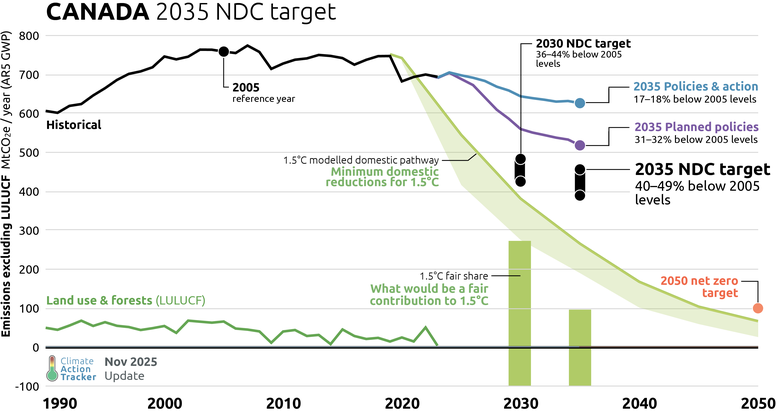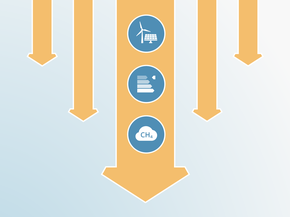2035 NDC
2035 NDC Target Overview
Canada’s new 2035 target is calculated based on emissions in 2005 excluding the forestry and land use sector (LULUCF), but the government plans to count the sector's emission reductions towards achieving the target: a “gross-net” approach. The CAT is critical of such accounting methods because relying on land sinks effectively reduces the pressure on governments to curb fossil fuel emissions.
Without including LULUCF, Canada's 45–50% target translates into a weaker reduction of 40–49% below 2005 levels. With improved forestry data in the 2024 National Inventory Report (NIR), Canada’s LULUCF shifted from a net sink to a net source of emissions across the entire historical period, highlighting the risk of relying on the land sink in meeting Canada’s climate targets (Environment and Climate Change Canada, 2024).
Canada did not strengthen its 2030 target in this NDC submission. Neither its previous 2030 target, nor the new 2035 target are 1.5°C compatible compared to modelled domestic pathways. Even more concerning, the gap between a 1.5°C compatible pathway and Canada’s target path is increasing from 2030 to 2035, from over 260 MtCO2e in 2030 to nearly 360 MtCO2e in 2035, raising concerns about Canada’s climate commitments.
While Canada's 2035 NDC target would need to be strengthened to be considered 1.5°C compatible, it does lead to emissions below current policies, meaning it should drive further mitigation action.
Canada did not strengthen its 2030 mitigation target in its 2035 NDC submission. A failure to substantially increase the ambition of Canada’s 2030 target and action makes limiting peak global warming to 1.5°C more difficult, requiring deeper and more rapid emission reductions elsewhere and likely leading to a multi-decadal, high overshoot of the limit even if followed by strong 2035 targets.
| Canada | 2035 NDC Target | |
|---|---|---|
| 2035 NDC target | ||
|---|---|---|
| Formulation of target in NDC |
Reduce GHG emissions in 2035 by 45% to 50% below the total national economic sector GHG emissions in 2005 (excluding LULUCF) with an accounting contribution from the LULUCF sector in 2035. [40–49% below 2005 levels by 2035 (excl. LULUCF)] |
|
| Absolute emissions level in 2035 excl. LULUCF |
Level of emissions to be achieved in total through domestic action and use of international market credits (full NDC target) 388–455 MtCO2e [25–36% below 1990] [38–47% below 2010] |
|
| Status | Submitted on 12 February 2025 | |
Ambition
For the world to have a significant chance of limiting warming to 1.5°C, governments must switch to emergency mode and strengthen both their 2030 targets and current policies to include substantial emissions cuts and significantly contribute to closing the 2030 emission gap. Canada’s 2035 NDC did not increase the ambition of its 2030 target.
2030 NDC Target
| 2030 NDC target | ||
|---|---|---|
|
Is the target 1.5°C compatible compared to modelled domestic pathways? |
|
|
| Is the target, international climate finance, and other forms of support 1.5°C compatible compared to fair share? |
|
|
|
Is this a stronger target than previously submitted? |
|
|
2035 NDC Target
| 2035 NDC target | ||
|---|---|---|
|
Is the target 1.5°C compatible compared to modelled domestic pathways? |
|
|
| Is the target, international climate finance, and other forms of support 1.5°C compatible compared to fair share? |
|
|
|
Does the NDC include sectoral targets? |
|
|
|
Does the NDC include a renewable energy capacity target? |
|
|
|
Does the target align with the country’s net-zero pathway? |
|
|
Canada submitted its 2035 Nationally Determined Contribution (NDC) mitigation target on 12 February 2025, setting a 2035 target of a 45–50% reduction in GHG emissions below 2005 levels. While this target is communicated as covering all sectors and all gases, the land use, land use change and forestry (LULUCF) sector plays a special role: Canada excludes LULUCF from the baseline, but partially counts its contribution to emissions reductions and removals towards meeting the 2035 target. For consistency and comparability across different countries, the CAT excludes emissions from LULUCF from this target, resulting in an emissions level of 388–455 MtCO2e in 2035 – or a reduction of 40–49% below 2005 levels.
The submitted NDC of 388–455 MtCO2e in 2035 is not 1.5°C compatible compared to modelled domestic pathways. To be 1.5°C compatible, Canada would need to reduce its emissions excluding LULUCF to 266 MtCO2e in 2035, equivalent to a reduction of 65% below 2005 levels.
To contribute to its fair share of climate action, Canada would need to even further reduce its domestic emissions and support emission cuts abroad through climate finance and other forms of support, equivalent to at least an 87% reduction below 2005 levels (excl. LULUCF).
Canada’s 2035 target requires slightly deeper emissions reductions than its 2030 target and theoretically aligns with the country’s net zero pathway. However, the annual reductions between the 2030 and 2035 targets (1–2%) are much lower than the annual reductions required between the 2035 and 2050 targets (9–10%). Our current policy projections show Canada far off track to meet its 2050 target. At an estimated level of between 606–608 MtCO2e in 2040, Canada would be left with several hundred megatons to reduce in 10 years in order to reach net zero – an unrealistic feat.
This effectively shifts a large part of the reduction burden into the post-2035 period, which makes achieving net zero more difficult. The gap between the pathway charted by these two targets and a 1.5°C compatible pathway is widening from 2030 to 2035, from over 260 MtCO2e in 2030 to nearly 360 MtCO2e in 2035.
Canada provides significant detail on its policies and actions in its 2035 NDC but has not updated the expected contribution per sector from the 2030 values communicated in its long-term strategy in 2022. This is a missed opportunity: sectoral targets bolster target achievement as they remove uncertainty on the required reductions for each economic sector.
The 2035 NDC target does not include sectoral targets though it lists sectoral actions in the power, industry, transport, buildings, agriculture and energy production sectors. Canada has published scenarios on possible 2050 sectoral compositions of its emissions but has not committed to interim sectoral targets on the path to 2050.
These actions partially align with the actions formulated in the Global Stocktake:
- Canada has introduced regulations that will reduce emissions from power generation, ensuring that Canada’s electricity system is net zero by 2050. A 1.5°C-aligned pathway would see Canada’s emissions from the power sector reach net zero by 2035 (Climate Action Tracker, 2023a).
- Canada has a phase-out date for the sale of fossil-fuelled light-duty vehicles by 2035, but this should likely be brought forward to 2030 (under the assumption that Canada should follow a similar path as implied by CAT benchmarks for the USA).
- Canada is a signatory to the Global Methane Pledge and is a significant methane emitter. In alignment with this pledge, its NDC restates plans to reduce methane emissions by at least 35% below 2020 levels by 2030, with a particular focus on the oil and fossil gas sector.
- Canada is a founding member of the Powering Past Coal Alliance and reconfirms its commitment to phasing out unabated coal power by 2030, although given its reliance on CCS this will not lead to zero emissions coal power by 2030.
Further information on Canada’s targets can be found here.
| Canada | Target summary (excluding LULUCF) |
|---|
| 2030 target: Emissions reductions below 2005 levels (CAT estimates) | ||
|---|---|---|
| Current policies in 2030 | 15% | |
| 2030 NDC target | 36–44% | |
| 1.5°C compared to modelled domestic pathways | 50% | |
| 1.5°C compared to fair share |
64% (To be reached by providing international climate finance and other forms of support that facilitate substantial emissions reductions internationally) |
|
| 2035 target: Emissions reductions below 2005 levels (CAT estimates) | ||
|---|---|---|
| Current policies in 2035 | 17-18% | |
| 2035 NDC target | 40–49% | |
| 1.5°C compared to modelled domestic pathways | 65% | |
| 1.5°C compared to fair share |
87% (To be reached by providing international climate finance and other forms of support that facilitate substantial emissions reductions internationally) |
|
There is still room to improve this NDC through an off-cycle update. Canada should:
- Submit fixed, absolute emissions reduction targets: Canada should communicate a fixed, absolute emissions reduction target for 2035 (excl. LULUCF) and align it with cost-effective 1.5ºC modelled domestic pathways, as well as providing a separate target for emissions removals from its LULUCF sink.
- Update the 2030 NDC target: Canada should revise and align its 2030 emissions target with 1.5ºC compatible modelled domestic pathways. Under the Paris Agreement, Canada committed to increasing the ambition of its NDCs – including its 2030 target. Updating the 2030 target could also be key in encouraging and motivating other countries to revisit and update their targets.
Fairness & Finance
Developed countries need to significantly scale up international climate finance and other means of support. Developed countries should set 1.5°C aligned domestic mitigation targets in their NDCs and communicate the financial and other support they will provide to developing countries. Developing countries should clearly communicate the climate finance they need to set and achieve ambitious 1.5°C aligned conditional targets.
| 2035 NDC target | ||
|---|---|---|
|
Does the NDC clearly communicate the climate finance contributions and other support to be provided and mobilised to other countries? |
|
|
Our methodology makes it clear that developed countries should set NDC targets that are at least compatible with their 1.5°C modelled domestic pathways and should meet these targets within their own borders and using their own resources. Canada’s submitted 2035 NDC is not 1.5°C compatible compared to modelled domestic pathways.
Developed countries are also expected to complement their ambitious domestic mitigation efforts with significant financial support for mitigation in other countries. Canada has communicated that it intends to channel “up to” CAD 3.2 billion (USD 2.3 billion) of its International Climate Finance envelope (2021-2026) to support mitigation in developing countries, but its contributions to date have been low. Canada also continues to fund fossil fuel development abroad. The CAT assesses Canada’s current climate finance commitments as "Highly insufficient."
To improve its 2035 NDC submission, Canada should set a floor, rather than a ceiling for its provision of climate finance for developing countries to facilitate substantial emission reductions internationally. The ceiling of CAD 3.2 billion (USD 2.3 billion) over a period of five years likely falls far short of Canada’s expected contribution to the 300 billion USD per year needed by 2030.
For more information on how the CAT assesses climate finance, see the finance rating methodology here.
Credibility
Credible NDCs should build on robust national planning processes that translate the economy-wide emissions reduction target into action in all sectors. Governments need to ramp up the implementation of their existing targets and further develop policies to close the – still significant – emissions gap between current policies and 1.5°C pathway. Contradictory policies must be addressed and reversed: fossil fuel production needs to be phased out, while fossil fuel exploration and fossil fuel subsidies need to stop.
| 2035 NDC target | ||
|---|---|---|
| Is the target driving more ambitious action? |
|
|
| Is there a policy framework in place to meet the target? |
|
|
|
Does the NDC reference national planning processes for its development? |
|
|
|
Does the NDC reference an institutional framework/plan in place for its implementation? |
|
|
|
Does the target commit to phase out fossil fuel production? |
|
|
|
Does the target commit to stop fossil fuel exploration & subsidies? |
|
|
Canada’s 2035 target is strong enough to spur additional action on domestic emissions reductions and Canada has a strong institutional framework in place to catalyse such action. However, our current policy projections for 2035 also show a significant implementation gap, with currently implemented policies and actions only reducing emissions by 17% below 2005 levels (excl. LULUCF). Urgent action will be needed to introduce, strengthen and implement policy mechanisms that turn this 2035 target into reality.
The major weakness of Canada’s climate action lies in the fossil fuel sector: although Canada’s NDC restates that it is ending public subsidies for new fossil fuel production projects, there are no provisions for a fossil fuel production phase-out – or even a commitment to stop the approval of new projects. Given that emissions from fossil fuel production represent almost a third of Canada’s total, the inability to curb oil and gas production and its expansion is a significant short-coming of Canada’s commitment to global climate action.
The CAT’s recent briefing on exported emissions shows that Canada is one of the top ten exporters of fossil fuel emissions in the world, with exported emissions being 147% of domestic emissions – in other words, almost 1.5 times the size of all the emissions produced by Canada’s own economy. Exported emissions have surpassed domestic emissions since 2015 and show no signs of stopping, increasing by over 50% between 2010–2022 (Climate Action Tracker, 2025). These activities undermine global efforts to limit warming to 1.5°C, as countries promised in the Paris Agreement.
According to an advisory opinion from the International Court of Justice (ICJ) in July 2025, such behaviour may also be illegal. The ICJ found that States have a legal obligation to protect the environment and limit greenhouse gas emissions – and breaching this responsibility may incur legal consequences (UN News, 2025). To regain its credibility and satisfy its international obligations, Canada must end support for fossil fuel exploration and move to permanently phase out fossil fuel production.
Transparency
Governments should set absolute, economy-wide, emission reduction pathways including all GHG gases, specifying the emissions levels for each year as an absolute level of gross emissions (excluding LULUCF). This level of clarity and transparency will ensure that their reduction targets are immune to creative accounting. NDC targets should primarily focus on their domestic reductions by decarbonising all sectors of the economy rather than relying on forestry sinks, other carbon dioxide removal (CDR) or international carbon markets.
| 2035 NDC target | ||
|---|---|---|
| Is the target based on a fixed base year or fixed absolute value? |
|
|
|
Does the target cover all sectors? |
|
|
|
Does the target cover all greenhouse gases? |
|
|
|
Does the target specify an emissions pathway? |
|
|
|
Does the target separate out land use and forestry? |
|
|
|
Does the target separate out other CO2 removal by type? |
|
|
|
Does the target separate out the use of carbon credits? (Article 6) |
|
|
Canada’s 2035 target is a 45–50% reduction below 2005 emissions (excl. LULUCF). However, Canada will count some of its LULUCF sink categories as well as potential engineered carbon dioxide removal towards its target achievement in 2035. This means the actual emission reduction across the economy might be lower, and the necessary structural changes towards a decarbonised economy could be slowed down.
When excluding Canada's projected contribution of LULUCF, we estimate that Canada's 2035 target is even less ambitious at 40–49% below 2005 levels, or 388–455 MtCO2e. This is not 1.5°C compatible compared to modelled domestic pathways.
If the Canadian government intends to use carbon credits under Article 6 of the Paris Agreement, then it should transparently communicate how it intends to use them and to what extent. Currently, Canada leaves the door open to supporting mitigation efforts abroad through the use of internationally transferred mitigation outcomes (ITMOs) but does not specify the amount. Rather than relying on carbon credits or unproven technologies like CCS, Canada should pursue proven solutions to effectively decarbonise its economy and transition away from fossil fuels.
The CAT’s latest briefing on Article 6 cautions against buying international carbon credits to delay or avoid investing in domestic mitigation, especially when developing high-quality, verifiable carbon credit projects remains extremely difficult. As an Annex I country, Canada should avoid purchasing so-called “low-hanging fruit” credits from developing countries, burdening them with a more difficult and expensive decarbonisation in the future, and should instead enhance its domestic ambition.
For more information on Canada’s climate targets and policies, please click here. For the CAT’s full recommendations for setting NDC targets that form the basis of the analysis above, please click here.
Further analysis
Latest publications
Stay informed
Subscribe to our newsletter





